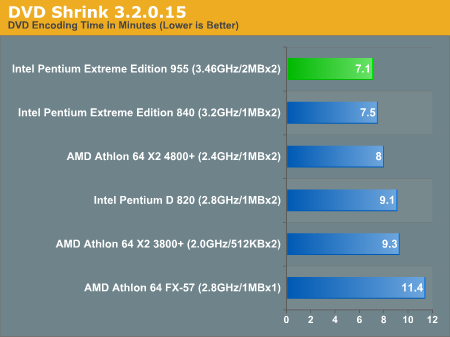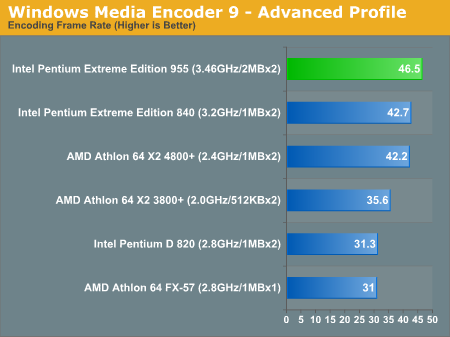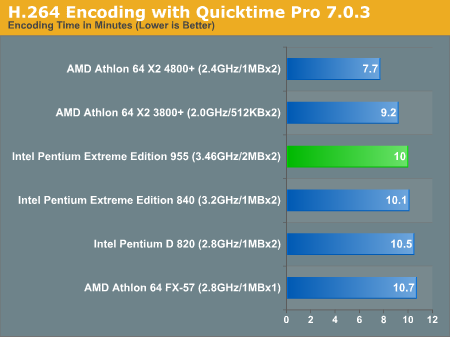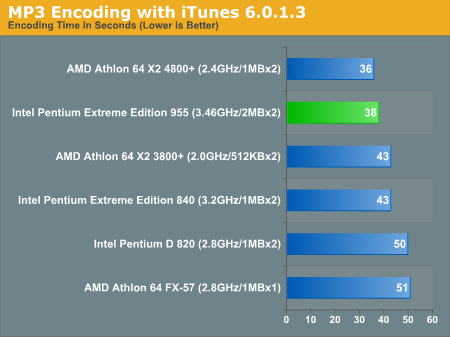Intel's Pentium Extreme Edition 955: 65nm, 4 threads and 376M transistors
by Anand Lal Shimpi on December 30, 2005 11:36 AM EST- Posted in
- CPUs
Media Encoding Performance using DVD Shrink, WME9, Quicktime and iTunes
First up is DVD Shrink 3.2.0.15. Our test was simple - we took a copy of Star Wars Episode VI and ripped the full DVD to the hard drive without compression, effectively giving us an exact copy of the disc on the hard drive. Then, using the copy of the DVD on the hard drive (to eliminate any DVD drive bottlenecks), we performed a DVD shrink operation to shrink the movie to fit on a single 4.5GB DVD disc. All of the options were left on their defaults, so the test ends up being pretty easy to run and reproduce. The scores reported are DVD encoding times in minutes, with lower numbers meaning better performance.
The DVD Shrink test is quite important as DVD Shrink is quite possibly one of the easiest tools to rip a DVD. The easier a tool is to use, the more likely it's going to be used, and arguably, the more important performance using it happens to be.
Moving on, we have our Windows Media Encoder 9 test, which uses the advanced profile settings for video encoding. We left all settings at their defaults and just proceeded with an MPEG-2 to WMV-HD conversion. The values reported are in frames per second, with higher numbers being better.
Next up, we have Quicktime Pro 7.0.3 and we perform a MPEG-2 to H.264 encoding task. All of the settings are left at their defaults, with the exception that we optimize the output file for download with a 256kbps data rate while leaving the resolution untouched. We also adjust the video options to optimize for the best quality. We report the transcoding time in minutes, with lower values being better.
Finally, we have a MP3 encoding test using iTunes 6.0.1.3. For this test, we simply took a 304MB wav file and converted it to a 192kbps MP3 file, measuring the encode time in seconds. The only iTunes option that we changed was to prevent the playback of the song while encoding.
First up is DVD Shrink 3.2.0.15. Our test was simple - we took a copy of Star Wars Episode VI and ripped the full DVD to the hard drive without compression, effectively giving us an exact copy of the disc on the hard drive. Then, using the copy of the DVD on the hard drive (to eliminate any DVD drive bottlenecks), we performed a DVD shrink operation to shrink the movie to fit on a single 4.5GB DVD disc. All of the options were left on their defaults, so the test ends up being pretty easy to run and reproduce. The scores reported are DVD encoding times in minutes, with lower numbers meaning better performance.
The DVD Shrink test is quite important as DVD Shrink is quite possibly one of the easiest tools to rip a DVD. The easier a tool is to use, the more likely it's going to be used, and arguably, the more important performance using it happens to be.

Moving on, we have our Windows Media Encoder 9 test, which uses the advanced profile settings for video encoding. We left all settings at their defaults and just proceeded with an MPEG-2 to WMV-HD conversion. The values reported are in frames per second, with higher numbers being better.

Next up, we have Quicktime Pro 7.0.3 and we perform a MPEG-2 to H.264 encoding task. All of the settings are left at their defaults, with the exception that we optimize the output file for download with a 256kbps data rate while leaving the resolution untouched. We also adjust the video options to optimize for the best quality. We report the transcoding time in minutes, with lower values being better.

Finally, we have a MP3 encoding test using iTunes 6.0.1.3. For this test, we simply took a 304MB wav file and converted it to a 192kbps MP3 file, measuring the encode time in seconds. The only iTunes option that we changed was to prevent the playback of the song while encoding.











84 Comments
View All Comments
Betwon - Friday, December 30, 2005 - link
NO.The speed is still very slow for AMD--latency 101ns. Even it is slow than the latency of RAM(5x ns -- 8x ns)
With so large a latency, we don't find any benefits for those apps which communicate frequently between 2 cores. But it will hurt the performance.
The best way for core-communication -- share L2 cache. The latency of yonah will be very low, much faster than AthlonX2 and Presler.
mlittl3 - Friday, December 30, 2005 - link
Not to mention the crossbar switch would not be possible if the dies were separated. Remember AMD did dual-core the right way by bringing the memory controller on die and using the crossbar switch to switch memory communications between the two cores with little latency. If the dies were separated the crossbar switch would have to be moved off die and that would make the whole point of on-die memory controller, well, pointless really.ricardo dawkins - Friday, December 30, 2005 - link
S939 AMD chip when these chips are phasing out by M2 and the like or i'm crazy ?Calin - Tuesday, January 3, 2006 - link
Because you can still find good processors for socket 754. Socket 939 will become the "value" or "mid-range" socket for AMD, and not the premier one (like it is now). New chips will come to socket 939, but the top of the line will be the new M2 - so a new 939 now is a good investment, that should be upgradable in a couple of yearsGriswold - Friday, December 30, 2005 - link
Would you rather recommend presler when the next big thing will yet again bring a new socket?ricardo dawkins - Friday, December 30, 2005 - link
Are you dead sure Conroe will need a new socket ?...LGA775 is with us for a few more years..stop spreading FUD. BTW, I'm not a intel fanboy but I read a lot of news.coldpower27 - Friday, December 30, 2005 - link
No your correct, there are images of the Conroe processor showing that it pin out is LGA775. I predict most likely we will ditch LGA775 when Intel ditiches NetBurst FSB technology in favor of CSI in 2008.JarredWalton - Friday, December 30, 2005 - link
Conroe should be socket 775, but it appears that it will require a new chipset - possibly 965/Broadwater, but it might also be something else. I am almost positive that 945/955 *won't* support the next gen Intel chips, which is too bad.michaelpatrick33 - Friday, December 30, 2005 - link
The power draw numbers from other websites are nothing short of frightening for Intel. They have closed the gap with AMD's current X2 4800 but at double the power draw. It is getting ridiculous that a 65nm processor uses more power at idle than a competitor's 90nm draw at full load. Conroe is the true competitor to AMD in 2006 and it will be interesting to see the power numbers for the FX-60 and new AMD socket early next year.Spacecomber - Friday, December 30, 2005 - link
I thought that part of the big news coming out in prior reviews of this chip was its overclocking potential. Not that anyone would necessarily buy this processor in order to overclock it, but it was suggestive of what the core was capable of.Unless I overlooked it, overclocking wasn't mentioned in this article.
Space